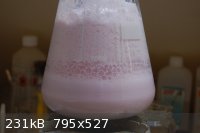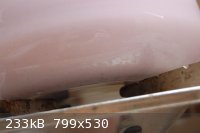| Pages:
1
2 |
hunharcos
Harmless

Posts: 1
Registered: 20-12-2008
Location: -
Member Is Offline
Mood: Friction Sensitive
|
|
Hi,
I faced some stupid problems, while making chlorate from Ca-bleach (Wouter's method).
I started out with 500 ml water and 250g hypochlorite (378g with all impurities).
When there were just a few gramms left to add, I came to realize that my thermometer had broken  . I know that I don't really need it in this reaction, but I like to feel having control on the reaction. . I know that I don't really need it in this reaction, but I like to feel having control on the reaction.
So, my questions are:
-Is the Hg reacts with anything important - paying no regard to the impurities?
-If yes, is the product soluble in water? (I know HgCl2s solubility at all temp.)
-How does the product affects the chlorate or the following procedures?
-The solution turned slightly pink after heating - even without Hg (first picture/SM1). Any guess why?
Now the Hg or Hg-compound is on the bottom (black coloured) and when boiling, some of those (veeery little) particles are flows up and sinks back
again (second picture/SM2).
If you guys say that there will be something trouble, i will discard it- regardless to the nature 
All answers, suggestions, hints-tips and tactics etc... are appreciated!
Thanks
 
-
|
|
|
Formatik
National Hazard
   
Posts: 927
Registered: 25-3-2008
Member Is Offline
Mood: equilibrium
|
|
The pink is the hypochlorite in aq. form (the same way NaClO takes on a yellow color). Hg from a thermometer will be oxidized. Some literature on
this: Hg when shaken with chloride of lime solution will form a grey, chloride-free powder and HgCl2 in solution (Souberain, Ann. Chim. Phys. [2] 48
[1831] 125; Lieb. Ann. 1 [1832] 267). Ca(ClO)2 solution in contact with Hg changes it to red oxychloride (Ballard, Ann. Chim. Phys. [2] 57 [1834]
301). Shaking Hg with hypochlorite solution forms CaCl2 and yellow HgO which eventually turns reddish (Wolters, J. pr. Ch. 115 [1873] 469; Dingl. J.
215 [1873]). That's the kind of impurities you're looking at.
That container is too narrow to be carrying out that reaction, try using a big glass pot since a lot of foaming occurs initially. Ca(ClO3)2 is very
impure with CaCl2, though you can effect some separation in the aq. phase. Separation can be done with acetone (solid phase separation, CaCl2 is
insoluble). Though alkaline ClO- you can boil till kingdom come and still have significant amounts of hypochlorite. Thermal decomposition of
commercial ClO- is a really a piss poor way to obtain chlorates. The only plus is the convenience of not generating toxic Cl2 gas. 
|
|
|
phys_geek
Harmless

Posts: 5
Registered: 7-8-2019
Member Is Offline
|
|
gr8 thread everybody.
Is this method good to make sodium chlorate also or the high solubility of sodium chlorate makes separation(and synthesis as result) impossible?
|
|
|
metalresearcher
National Hazard
   
Posts: 758
Registered: 7-9-2010
Member Is Offline
Mood: Reactive
|
|
Quote: Originally posted by phys_geek  | gr8 thread everybody.
Is this method good to make sodium chlorate also or the high solubility of sodium chlorate makes separation(and synthesis as result) impossible?
|
When you want to make NaClO3, you can better electrolyze table salt.
|
|
|
| Pages:
1
2 |